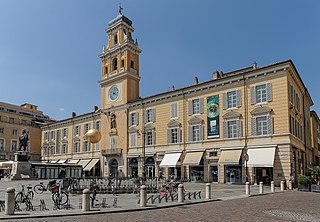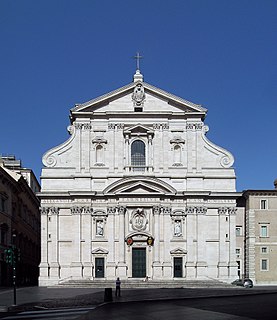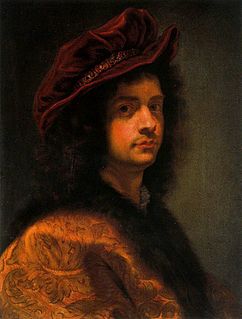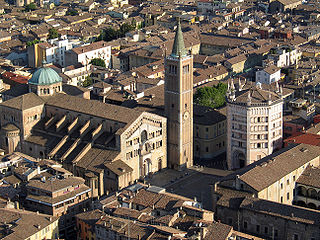The Santissima Annunziata, also called the Basilica del Paradiso, is a Renaissance style, Roman Catholic church and convent located on Via Massimo D'Azeglio in Parma, Italy.
Contents

The Santissima Annunziata, also called the Basilica del Paradiso, is a Renaissance style, Roman Catholic church and convent located on Via Massimo D'Azeglio in Parma, Italy.

The church was built on a site of a convent once occupied by the Franciscan Order outside the city walls, but demolished in 1546 by the Duke Pier Luigi Farnese. Originally the church was dedicated to Saints Gervaso and Protaso. Construction began in 1566, commissioned by Duke Ottavio Farnese and the bishop of Brugnato, and using a design by Giambattista Fornovo.
By 1616, construction had stalled, part of the roof fallen in, and there was a failure to complete the planned dome. Only with the intervention of Margherita Farnese (who became a nun) did construction proceeded using an awkward, heavily buttressed dome design by Girolamo Rainaldi. The layout has a nearly elliptical interior, with two semi-circles joined by two straight lines, which join the apse, ten chapels, and an interior atrium.
The convent was designed in part by Giovanni Battista Magnani, with the refectory completed in 1637 and cloister in 1688. The convent includes a large library. The convent contains the rooms and artifacts of the Blessed Lino Maupas (died 1924). [1]
In the left atrium there is a copy of the Annunciation by Correggio (1520), a fresco from the church of the Minors in via Farini. [2] In the niche is an polychrome terracotta sculpture depicting Ecce Homo by Antonio Sbravati, and a Martyrdom of Saints Gervaso and Protaso (early 19th-century) by Biagio Martini. The main altarpiece is an Enthroned Madonna, Child and Saints Bernard, John Baptist, John Evangelist and Francis of Assisi (1776) by Antonio Brianti, is a copy of a work (1518) by Francesco Zaganelli for the church of the "Annunziata di fuori".
In the fourth chapel to the left, there are depictions of Life of St Peter of Alcantara (early 18th-century) by Pier Ilario Spolverini. In the ninth chapel, there is a St Bonaventure genuflecting before the Virgin by Sebastiano Galeotti. In the tenth chapel, there is the baptismal fountain by Camillo Uccelli. Among other artists with works is Giovanni Battista Tinti.
The Baroque stucco decoration in the nave is attributed to Luca and Giovanni Battista Reti. The organ is by Giuseppe Serassi. [3]

Parma is a city in the northern Italian region of Emilia-Romagna famous for its architecture, music, art, prosciutto (ham), cheese and surrounding countryside. With a population of 198,292 inhabitants, Parma is the second most populous city in Emilia-Romagna after Bologna, the region's capital. The city is home to the University of Parma, one of the oldest universities in the world. Parma is divided into two parts by the stream of the same name. The district on the far side of the river is Oltretorrente. Parma's Etruscan name was adapted by Romans to describe the round shield called Parma.

The Church of the Gesù is the mother church of the Society of Jesus (Jesuits), a Catholic religious order. Officially named Chiesa del Santissimo Nome di Gesù all'Argentina, its facade is "the first truly baroque façade", introducing the baroque style into architecture. The church served as model for innumerable Jesuit churches all over the world, especially in the Americas. Its paintings in the nave, crossing, and side chapels became models for Jesuit churches throughout Italy and Europe, as well as those of other orders. The Church of the Gesù is located in the Piazza del Gesù in Rome.

Giovanni Battista Gaulli, also known as Baciccio or Baciccia, was an Italian artist working in the High Baroque and early Rococo periods. He is best known for his grand illusionistic vault frescos in the Church of the Gesù in Rome, Italy. His work was influenced by Gian Lorenzo Bernini.

Illusionistic ceiling painting, which includes the techniques of perspective di sotto in sù and quadratura, is the tradition in Renaissance, Baroque and Rococo art in which trompe-l'œil, perspective tools such as foreshortening, and other spatial effects are used to create the illusion of three-dimensional space on an otherwise two-dimensional or mostly flat ceiling surface above the viewer. It is frequently used to create the illusion of an open sky, such as with the oculus in Andrea Mantegna's Camera degli Sposi, or the illusion of an architectural space such as the cupola, one of Andrea Pozzo's frescoes in Sant'Ignazio, Rome. Illusionistic ceiling painting belongs to the general class of illusionism in art, designed to create accurate representations of reality.

Giovanni Lanfranco was an Italian painter of the Baroque period.

Parma Cathedral is a Roman Catholic cathedral in Parma, Emilia-Romagna (Italy), dedicated to the Assumption of the Blessed Virgin Mary. It is the episcopal seat of the Diocese of Parma. It is an important Italian Romanesque cathedral: the dome, in particular, is decorated by a highly influential illusionistic fresco by Renaissance painter Antonio da Correggio.

San Carlo ai Catinari, also called Santi Biagio e Carlo ai Catinari is an early-Baroque style church in Rome, Italy. It is located on Piazza Benedetto Cairoli, 117 just off the corner of Via Arenula and Via dei Falegnami, a few blocks south of the church of Sant'Andrea della Valle.

Sant'Anna dei Lombardi,, and also known as Santa Maria di Monte Oliveto, is an ancient church and convent located in piazza Monteoliveto in central Naples, Italy. Across Monteoliveto street from the Fountain in the square is the Renaissance palace of Orsini di Gravina.

Gregorio de Ferrari was an Italian Baroque painter of the Genoese school.

The Tempio della Beata Vergine della Ghiara, also known as Basilica della Madonna della Ghiara, is a church in Reggio Emilia, northern Italy. The building is the property of the comune (municipality) of the city.

The Basilica della Santissima Annunziata del Vastato is a Catholic cathedral in Genoa, northern Italy; its decoration employed the major baroque studios and artists in Genoa in the 17th century.

San Nicola da Tolentino agli Orti Sallustiani is a church in Rome. It is referred to in both Melchiori's and Venuti's guides as San Niccolò di Tolentino, and in the latter it adds the suffix a Capo le Case. It is one of the two Roman national churches of Armenia. The church was built for the Discalced Augustinians in 1599, and originally dedicated to the 13th century Augustinian monk, St. Nicholas of Tolentino.

The Shrine of Santa Maria della Steccata is a Greek-cross design Renaissance church in central Parma, Italy. The name derives from the fence or steccato used to corral the numerous devotees who visited a venerated image of the Madonna. A Nursing Madonna is enshrined within, crowned on 27 May 1601 by a Marian devotee, Fray Giacomo di Forli of the Capuchin order.

San Giovanni Evangelista is a church in Parma, northern Italy, part of a complex also including a Benedictine convent and grocery.

San Francesco is a medieval Roman Catholic church in Piacenza, Italy. It was built for a Franciscan order in a style described as Lombard Gothic.
San Pietro is a Roman Catholic church in central Piacenza, Emilia Romagna, Italy. The church was built over the site of an ancient church titled San Pietro in Foro.

San Vitale is a Baroque style, Roman Catholic church located in central Parma, region of Emilia Romagna, Italy.

San Paolo is a former convent in central Parma, Emilia-Romagna, northern Italy. It is best known for housing the Camera di San Paolo, decorated by a masterpiece of fresco work (1519) by Correggio.

Santa Cristina is a Baroque-style, Roman Catholic church located on via Repubblica in Parma, region of Emilia-Romagna, Italy.

The Cappella di San Luca, also called dei Pittori is a chapel found in the cloisters of the convent of Santissima Annunziata in Florence, Italy. It was built to serve as the burial chapel for members of the Accademia del Disegno, and was donated by the Servites to the Academy in a document from 1565. It contains a collection of terracota statues from a number of prominent Florentine Mannerist sculptors.
Coordinates: 44°48′9.35″N10°19′17.80″E / 44.8025972°N 10.3216111°E